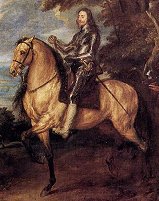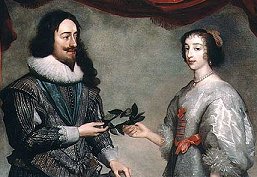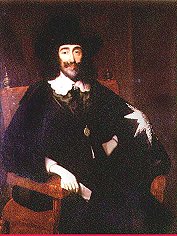Little concern would probably have been shown about the accession of
Charles 1 in 1625, but the new King was to visit Wolverhampton three
times during his reign of twenty four years. For the majority of his
reign the king and parliament were at loggerheads, and during the years
1629-1640 no parliament was summoned. As a result, the king needed to
raise money by unusual means and introduced some measures which affected
Wolverhampton. It had long been the custom for towns on the coast to
provide the monarch with ships for the navy or money in place of the
ships at times of need. Charles decided that this was a time of need but
he extended the duty, known as Ship Money, to inland towns as well.
During the years 1635-1639 the communities at Willenhall, Wednesfield
and Wolverhampton each contributed a sum in ship money. The amount for
Wolverhampton was £72 which was collected from the richer inhabitants
with contributions varying from a shilling to about 6s 8d. A second
source of revenue for Charles was 'knighthood fines'. This involved
anyone who held freehold land to the value of £40 per year and should
therefore undertake the duties of knighthood, or pay a fine of £10 if
the duties were not to be undertaken. Charles managed to raise £120 from
Wolverhampton's freeholders.
 |
The King on Horseback. |
When the civil war broke out in 1642 the great families of the area
were divided with the Levesons and the Giffards fighting for the King,
and the Wrottesleys and the Lanes fighting for parliament. Most of the
ordinary townsfolk were probably disinterested although some observers
regard the town as having had royalist sympathies.
The district saw a good deal of marching armies, many Royalists
armies, but little in the way of fighting. Although there were two
garrisons at Wolverhampton, there were no battles or skirmishes in the
town. There had been one unfortunate event prior to the outbreak of
fighting when a number of "persons broke into the parish church and
broke down the rail about the communion table standing in the chancel,
and pulled up a mat there within the rail, and about the communion
table, and did at the same time pull it to pieces, and did remove the
communion table out of the chancel into the body of the church."
The first blow in the Civil War in Wolverhampton was struck when
Thomas Leveson called on John Tanner a 'stinking rogue' and struck him
about the head with a stick making "a great knob in the skin thereof".
The reason for the attack was that Tanner, an armourer, refused to
return armour to Leveson because he knew him to be a Catholic, and a
Royalist sympathiser. The blow to John Tanner was not only the first but
also the last show of force during the war in the town.
| King Charles I and Queen Henrietta Maria. |
 |
The King himself arrived in the town on Saturday
October 15 1642. He had marched from Shrewsbury, by way of Bridgnorth,
Trescote and Compton and took up residence at the house of a Madame St.
Andrew which was situated in Cock Street (Victoria Street) on the site
of the former Star and Garter. Prince Rupert, who was accompanying his
uncle, stayed in a house in Lichfield Street. It was during this visit
that a wealthy merchant of the town, Henry Gough, craved a personal
interview and presented £l200 in gold to the King for the Royalist
cause. On the advice of Thomas Bushell, the King took the opportunity of
rewarding his men for their endeavours. He presented each colonel with a
medal of a 20s piece in silver, all other officers received half a
crown. Thomas Bushell's reasoning was probably, that, without reward,
the King's soldiers could well desert. It proved wise advice since the
Battle of Edgehill took place on Sunday, October 23rd 1942.
Prince Rupert made another visit to the town early in 1643 on his way
to Lichfield. It was during this visit that the Prince used a very
persuasive method of recruiting. He threatened to "hang, draw and
quarter anyone between the ages of 16 and 60 who did not choose to fight
for their King."
After the battle of Hopton Heath in March 1643 a Parliamentarian
force led by Sir William Brereton entered the town at about three
o'clock in the morning and "captured" it. The victors met with no
resistance. Thomas Leveson, the Royalist Commander in the town, had left
his family home at the Great Hall, later known as Old Hall Street, and
took up residence at Dudley Castle. Leveson had not been too popular
during his stay in Wolverhampton especially when his soldiers were
lodged in St Peter's Church where they did a great deal of damage and
showed very little reverence for their surroundings. The
Parliamentarians took their revenge by seizing all of Leveson's
property, in the area including Bilston where the steward Will Tomkys,
came very close to being killed for refusing to give any information
about his master to the Parliamentarians.
The next visit to Wolverhampton by the King happened in May 1645 when
he and Prince Rupert were on their way to the last great battle of the
first Civil War, at Naseby. While the Prince slept in the town, the King
stayed at "a private sweet village where Squire Grosvenor lives" (the
King's own words). The village was Bushbury.
After the Royalist defeat at Naseby the King made his last visit to
the town when he stayed overnight at the home of a Mrs. Barnford in Cock
Street (Victoria Street).
In February 1646 Sir William Brereton and Colonel Sanderson assembled
a Parliamentary force of three thousand men (1800 infantry and 1200
cavalry) in the town. The intention was to use the force against
Lichfield and other local fortresses.
 |
King Charles at his trial. |
The execution of King Charles I happened on January
30, 1649 and two years later his eldest son, Charles Stuart, returned
from exile determined to regain his father's throne. However the army of
the Stuarts was defeated at Worcester on Wednesday, September 3 1651 and
the Prince became a fugitive. It was after the battle that the area
around Wolverhampton once again played a part in national history. On
the evening of the battle Prince Charles and a few friends left the city
of Worcester and rode north. When he arrived at Kinver he rested for a
few minutes and then continued his journey north. He planned to try and
get to Wales and raise another army there. He rode on to Stourbridge and
through Himley and then he cut across country by way of Wombourne and
Pattingham, finally arriving at White Ladies Priory near Tong at about 3
o'clock in the morning.
George Penderel, a servant at White Ladies, let Charles' party into
the Priory and then sent for two of his brothers, Richard and William.
The Prince was then disguised and made to look like a Country fellow.
His name was to be William Jones and his job a woodcutter. He was then
taken by Richard into Spring Coppice, a wood nearby, where he spent the
day. Less than one hour after the Prince left While Ladies, a group of
Parliamentary soldiers arrived. After a search, they left without
finding any trace of Charles.
That evening Charles, escorted by Richard, George and Humphrey
Penderel, was taken to Richard's home, Hobbat Grange. There, Jane
Penderel. the mother of the five brothers, gave Charles a meal. Still
disguised as the woodcutter, he set out with Richard as his guide to
walk to Madeley. He hoped to cross the Severn and escape into Wales.
At Evelith Mill the miller called after them and wanted to know who
they were but they did not stop to answer questions. Having reached
Madeley Charles discovered that the river was too heavily guarded to
make a crossing. The Prince hid all day in the barn adjoining Upper
House, Madeley. Then Charles disguised himself again and after a meal
returned with Richard towards Boscobel. The two men avoided Evelith Mill
and crossed the Warfe a little further down, arriving at Boscobel in the
early hours of Saturday September 6, 1651. It was at Boscobel that
Charles met Major Careless. According to popular belief Charles and
Major Careless spent most of the day in an oak tree whilst
Parliamentarian soldiers searched the surrounding area for any sign of
the "tall man above two yards high, with dark brown hair". The oak tree
was probably a secure hiding place since Boscobel was surrounded by
woods and it would have been extremely difficult to find anyone in those
woods. That night Charles learned that a reward of £1000 had been placed
on his head and a penalty of death for anyone who aided or abetted him
in his escape.
During the Sunday evening Charles, once again accompanied by the
Penderels, travelled to Moseley Old Hall. The Hall belonged to the
Whitgreve family and it was their family priest, Father John Huddleston,
who led the Prince to the back door of the Hall. As a Catholic family
the Whitgreves were prepared for any searches of the house, and so the
Prince was hidden in one of the priest's holes in the house. He stayed
at Moseley for two days. On the evening of Tuesday September 7th Charles
and a Colonel Lane left Moseley and travelled to Bentley Hall. The
Prince only stayed long enough for a brief rest at Bentley before he
left for Bristol, where he hoped to get a ship to France. He dressed
himself up as the servant of a Miss Jane Lane and gave himself the name
of Will Jackson.
Six days later Charles was in France, not to return until May 1660
when he was restored to the throne of England.

 |
Return to the
previous page |
|